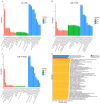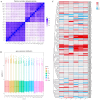Genome-Wide Identification and Expression Analysis of NAC Gene Family Members in Seashore Paspalum Under Salt Stress
- PMID: 39771292
- PMCID: PMC11678376
- DOI: 10.3390/plants13243595
Genome-Wide Identification and Expression Analysis of NAC Gene Family Members in Seashore Paspalum Under Salt Stress
Abstract
The NAC gene family plays a crucial role in plant growth, development, and responses to biotic and abiotic stresses. Paspalum Vaginatum, a warm-season turfgrass with exceptional salt tolerance, can be irrigated with seawater. However, the NAC gene family in seashore paspalum remains poorly understood. In this study, genome-wide screening and identification were conducted based on the NAC (NAM) domain hidden Markov model in seashore paspalum, resulting in the identification of 168 PvNAC genes. A phylogenetic tree was constructed, and the genes were classified into 18 groups according to their topological structure. The physicochemical properties of the PvNAC gene family proteins, their conserved motifs and structural domains, cis-acting elements, intraspecific collinearity analysis, GO annotation analysis, and protein-protein interaction networks were analyzed. The results indicated that the majority of PvNAC proteins are hydrophilic and predominantly localized in the nucleus. The promoter regions of PvNACs are primarily enriched with light-responsive elements, ABRE motifs, MYB motifs, and others. Intraspecific collinearity analysis suggests that PvNACs may have experienced a large-scale gene duplication event. GO annotation indicated that PvNAC genes were essential for transcriptional regulation, organ development, and responses to environmental stimuli. Furthermore, the protein interaction network predicted that PvNAC73 interacts with proteins such as BZIP8 and DREB2A to form a major regulatory hub. The transcriptomic analysis investigates the expression patterns of NAC genes in both leaves and roots under varying durations of salt stress. The expression levels of 8 PvNACs in roots and leaves under salt stress were examined and increased to varying degrees under salt stress. The qRT-PCR results demonstrated that the expression levels of the selected genes were consistent with the FPKM value trends observed in the RNA-seq data. This study established a theoretical basis for understanding the molecular functions and regulatory mechanisms of the NAC gene family in seashore paspalum under salt stress.
Keywords: NAC TFs; Paspalum Vaginatum; molecular breeding; qRT-PCR; salt stress response.
Conflict of interest statement
The authors declare no conflicts of interest.
Figures






References
Grants and funding
LinkOut - more resources
Full Text Sources

